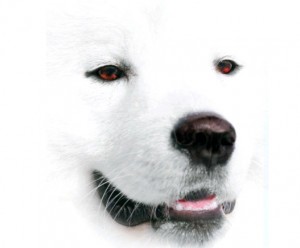Breed Priorities – Samoyed
298 – June, 2016
By Nikki Riggsbee
 The Samoyed was developed by nomadic people in Siberia. The dogs were working dogs, helping with reindeer herding, hunting, and pulling sleds. Rumor has it that it was one of the breeds referred to in the phrase “three dog night,” where it was so cold that you need three dogs in bed with you. Samoyeds are considered one of thirteen basal breeds that have been found genetically divergent from modern breeds.
The Samoyed was developed by nomadic people in Siberia. The dogs were working dogs, helping with reindeer herding, hunting, and pulling sleds. Rumor has it that it was one of the breeds referred to in the phrase “three dog night,” where it was so cold that you need three dogs in bed with you. Samoyeds are considered one of thirteen basal breeds that have been found genetically divergent from modern breeds.
Fifty-two Samoyed breeder-judges and mentors were invited to take a survey on which this article on their breed’s priorities would be based. Thirty-two agreed to participate, twenty of whom returned completed surveys. The group averaged over 41 years in the breed. All but two were judges, averaging nearly sixteen years judging Samoyeds. Most have judged the National specialty and other Samoyed specialties.
Samoyed Virtues
The experts were asked to rank a list of virtues taken from the Samoyed standard. The list of characteristics is below in sequence by the average of the ranks, with 1 being the most important.
1. Gait free, balanced, vigorous, with good reach and good driving power
2. (Front) Legs approximately 55% of height at withers 3. Off-square – length 5 percent more than height
4. Shoulders long, sloping, with layback of 45 degrees,firmly set
5. Back straight to loin, medium in length, very muscular,neither long nor short-coupled
6. Stifles well bent – approximately 45 degrees to the ground 7. Coat heavy, weather-resistant, double, quality rather than quantity
8. Chest deep, with ribs well-sprung
9. Eyes dark, placed well apart, deep-set, almond-shaped, lower lid slanting toward base of ears
10. Skull forms an equilateral triangle between inner base of ears and center of stop
11. Muzzle medium-length, medium-width, must have depth 12. Ears strong, thick, erect, triangular, slightly rounded tips, set well apart but within border of the head
13. Feet large, long, flattish – a hare-foot
14. Lips black and slightly curved up at the corners of the mouth
15. Tail carried forward over the back or side when alert 16. Scissors bite
298 – June, 2016
Short URL: http://caninechronicle.com/?p=105654
Comments are closed











